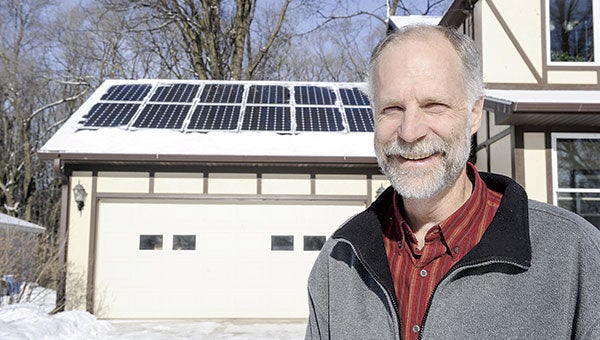Tour touts solar panels in Austin
Published 10:31 am Thursday, October 2, 2014

Chuck Meyer, a biology and Earth science instructor at Riverland installed solar panels on his home, making it much more sufficient. His home will be featured on the Minnesota Renewable Energy Tour this weekend. Herald file photo
Chuck Meyer’s garage has been helped him cut his energy bills for almost a year.
That’s because Meyer and his wife, Leslie, have a 12-panel, 3.3 kW solar panel on their garage, which has reduced their energy bill by an average of $37 over each of the last 11 months.
“They’ve been so good to us,” Meyer said. “We’ve been producing more electricity than we use.”
The Meyers’ home is one of three Austin locations set up to participate in the Minnesota Renewable Energy Tour from 10 a.m. to 4 p.m. on Saturday.
The self-guided tour is free and open to the Public. Attendees can go to listed sites, where home or business owners will be present to share first-hand information on their experiences with solar, wind, geothermal and other energy efficiency measures.
The 12-panel solar panel system was installed on the garage a little less than a year ago.
“The panels were put up last fall, and we got turned on and hooked up to the grid on Nov. 21 last year, so we’re coming up on a year here in a little bit,” Meyer said.
More than 40 homes, farms, schools, municipalities and businesses in Minnesota will join the Minnesota Renewable Energy Society and American Solar Energy Society, as well as 150,000 other renewable energy system installers and owners throughout America, to showcase more than 5,000 alternative-powered sites for the 19th Annual National Solar Tour, the world’s largest grassroots renewable energy event.
Along with Meyer’s 3.3 kW solar panel, other sites include the Worlein Funeral Home’s 3 kW of solar panel and the Owens family, who used two areas of roof space to install 2.6 kW of solar panels.
Participants can connect with a home or business owner and hear about real life experiences with renewable energy systems, including financing and assistance available to nonprofits, schools and businesses.
The Meyers’ solar panels have covered about 170 percent of their electric needs since they put them up.
Though the solar panels have reduced his energy bills, he pointed out there is a difference between winter, which has less sun, and summer, which has more sun.
Because the solar panels can’t always provide enough energy for their needs, the home is also hooked up to Austin Utilities for electricity. Although he said it has not reduced their utilities bill to nothing, it has reduced it.
“We’re what is called grid-tied; we’re still hooked up to Austin Utilities,” Meyer said. “Clearly the sun doesn’t always shine, but we still want to use our lights.”
Because the Meyers’ solar panels are hooked to the main grid, what the couple doesn’t use goes into the main grid and is used for other customers. Austin Utilities then gives credit back to the couple for the energy they gain, because the Meyers still use gas and water with the company.
“It adds a big credit to our utility account. We pay less as a result,” Meyer said.
Although the systems are many times expensive to purchase and install, Meyer said they are worth the cost.
“These systems, given enough time, do end up paying for themselves, but you just have to be a little bit patient on that,” Meyer said.
Meyer has always been interested in solar-energy. As a biology teacher at Riverland Community College in Austin, one of the main courses he teaches is environmental science. This was one of several reasons that got him to look into actually purchasing the panels. Once the cost came down, he jumped at the chance.
“That’s been in the back of my mind for years, but for so long they were just so exorbitantly expensive,” Meyer said. “It just became financially doable. It’s not a get-rich-quick scheme by any stretch of the imagination though.”
The total cost of his 12-panel system, with the install cost, came to just under $16,000. Yet because of a rebate program through Austin Utilities, and a federal tax credit, the net cost was about $8,800.
Because the technology is always changing and becoming better, the price consistently drops as well. Meyer said the cost of the panels since 2008 has fallen about 80 percent.
“It’s a technology that’s just now becoming affordable for people who are like me and are interested in really doing this now,” he said. “And I wouldn’t be surprised if in the next five to 10 years we see a lot of solar systems go up.”
Meyer is excited about the tour on Saturday.
“I would hope people see is that residential solar energy systems are a very real and viable option for people who have some exposure to the sunlight during the day,” Meyer said.
“I have no idea how many will show up, we’ll see,” he added. “As long as the sun is shining that’ll be good.”
To find tour sites, visit the website at www.mnrenewables.org/solar-tour. There is an interactive map detailing each tour location that can be used to get directions and plan a route. Look for a yellow balloon at the end of the driveway to mark participating sites. Someone will be on hand at each location to give a tour and answer questions.





